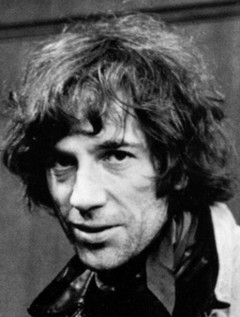Donald Cammell (Donald Seaton Cammell)

Donald Cammell was born in the Camera Obscura (then known as Outlook Tower) on Castlehill, near the castle in Edinburgh, Scotland, the son of the poet and writer Charles Richard Cammell (who authored a book on occultist Aleister Crowley). Donald Cammell was educated at Shrewsbury House School and Westminster School. Brought up in a bohemian atmosphere, Donald Cammell was raised in an environment he described as ”filled with magicians, metaphysicians, spiritualists and demons” including Aleister Crowley, the great inspiration behind Kenneth Anger’s life and work. Cammell was a precociously gifted painter, winning a scholarship to the Royal Academy at age 16. He subsequently studied in Florence and made his living as a society portrait painter. While still in his late teens, The Times hailed one of his portraits as ”society portrait of the year.” He had a short-lived early marriage that produced a son. After its disintegration he moved to New York to live with model Deborah Dixon and concentrate on painting nudes, which helped him to satisfy his notable sexual appetite – he had the reputation of being irresistible to women – but not his creative desires. He moved to Paris and began writing screenplays; first a thriller called The Touchables, then a collaboration with Harry Joe Brown Jnr called Duffy. This caper movie was directed by Robert Parrish in 1968 (and featured James Fox), an artistic failure that frustrated Cammell to the point that he decided to direct. Through his friendship with Anita Pallenberg he came into the orbit of the Rolling Stones and moved to London.
In her autobiography ” A Story Lately Told: Coming of Age in Ireland, London and New York”, Anjelica Huston refers to Donald Cammell during his London period as “a dangerous man” and alludes to him drugging and raping her. “Whatever it was he gave me, everything went sideways.”2 After Performance, he wrote a script called Ishtar that was to feature William Burroughs as a judge kidnapped while on holiday in Morocco. Like most of the scripts he worked on, it remained unproduced. His unwillingness to compromise his ideas alienated him from the Hollywood establishment that perceived him as an eccentric troublemaker. Several of Cammell’s major frustrations involved Marlon Brando. In 1978, Brando invited Cammell to collaborate on a script called Fan Tan which Brando soon lost interest in; then he asked Cammell to adapt the script as a novel and again scuttled the project half way through by losing interest. In 1989 Brando employed Cammell to direct a script he had written called Jericho. After eighteen months of work, while on pre-production in Mexico, Brando again decided he didn’t want to go through with the project. The next project Donald Cammell managed to get made was a short called The Argument (1971/99) that was shot on location in the Utah desert by Vilmos Zsigmond on the sly. Cammell had obtained the camera on the grounds that Zsigmond was shooting tests for another film. This confrontation between a frustrated film director and a goddess (played by Myriam Gibril, Cammell’s lover and Isis to his Osiris in Lucifer Rising) covers many of Cammell’s favourite themes, but Cammell never completed the film. It was rediscovered and put together by his editor, Frank Mazzola, in 1999.
Donald Cammell’s next feature was Demon Seed (1977). Although not a personal project, this science fiction thriller (based on a book by Dean R. Koontz featured many of Cammell’s obsessions. A super-computer takes over a scientist’s house with his wife (Julie Christie) inside and proceeds to terrorise and ultimately impregnate her. A two-hander between Christie and the computer, Demon Seed’s mind games and closed environment are reminiscent of Performance, while the idea of the machine giving a child to the heroine and thus providing itself with a human incarnation is another example of Cammell’s fascination with transformative sexuality. Cammell had to wait until 1987 to complete another project, White of the Eye. This study of a serial killer features a return of his crosscutting techniques ‘(absent from Demon Seed).
Donald Cammell committed suicide by shotgun. According to sensesofcinema.com, “The death of Donald Cammell was as flamboyant and dramatic as anything he had ever filmed. Haunted by death and suicide for many years, he took his own life in 1996 at age sixty-two with a gunshot to the head. But he fired into the top of his head instead of the roof of his mouth with the result that he was alive and conscious for up to 45 minutes afterwards and, reportedly, was in a happy, almost euphoric state. The fact that he didn’t die instantly was not accidental; in fact he allegedly requested that his wife and writing collaborator China Cammell hold up a mirror so he could watch himself die and asked her ‘Do you see the picture of Borges?’. This was a reference to the climax of the only film that he is widely remembered for today, Performance (1968, released 1970), in which gangster Chas (James Fox) shoots reclusive rock star Turner (Mick Jagger). In a startling move, the camera plunges after the bullet into the hole in Turner’s head only to end up confronting a photograph of Jorge Luis Borges, a writer much quoted in the dialogue and – like Burroughs and Genet – a literary influence on the film as a whole. Performance is a film about the merging of opposites, of male and female, of identities, of personae, of the apparently different worlds of gangsterism and extreme artistic decadence that are both revealed to function through the engine of the performative ritual of violence. Or, as the tagline had it: ‘Vice. And Versa’”.
Born
- January, 17, 1934
- United, Kingdom
- Edinburgh, Scotland
Died
- April, 24, 1996
- USA
- Hollywood, Florida
Cause of Death
- gunshot wound

